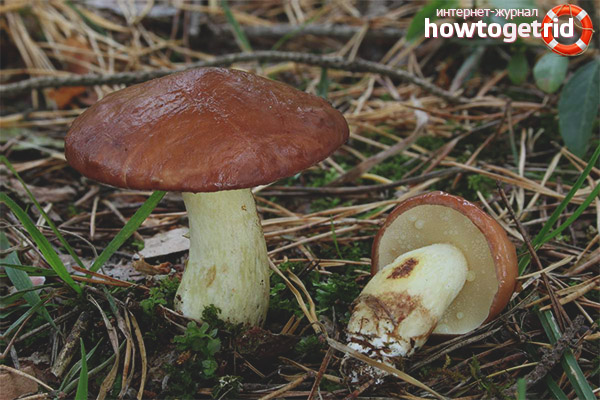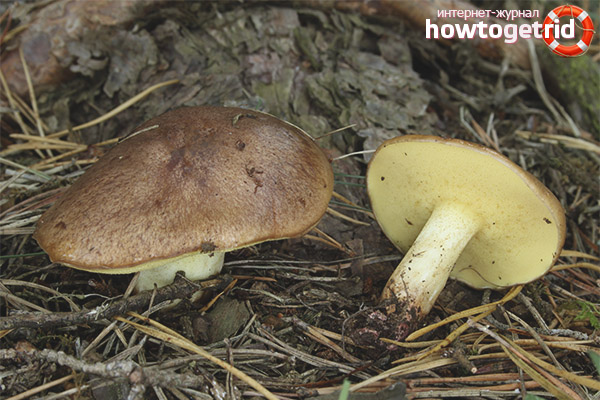The content of the article
Usually, forest mushrooms begin to appear after a good summer rain, popularly called mushroom. But this does not apply to all species - there are those that appear in the hottest weather. Only, unfortunately, they do not last long, and catastrophically quickly become worthless - insects begin to devour them intensely. Such mushrooms include a granular oiler.
Description
A grainy oiler (also called an early oiler or a summer oiler) is probably the most popular and most common mushroom in Russian forests. An oiler for the Russian forest is about the same as russula. It also grows in large quantities. What does he look like?
The hats of this mushroom grow large - from 20 mm in a very young mushroom to 10-15 cm in an adult. At first, butterflies are born with a rounded hat, over time it becomes more flat. Top covered with skin with traces of mucus drying out in the heat, color in brown-red-red shades. The skin during the processing of the fungus is very easily removed.
The pulp of the mushroom is soft and taut, white-yellowish in color, smells a bit of resin, the color does not change during a break. Covers (that is, film) does not have.
The bottom of the hat consists of thin tubes, light yellow in young mushrooms, adults have gray-yellow, dark yellow or buffy color. The tubules secrete white milk, which, when dried, turns into specks of gray-brown color.
The spores are smooth and oval, painted in an olive-ocher color.
Where is growing
It is very widespread - it grows in coniferous and aspen forests of the Caucasus, in the Urals, throughout Siberia and the Far East, almost all the forests of Europe are occupied with oils, even in distant Israel there is this mushroom. A lot of butter in young forests, in clearings, can be found in glades and along any forest road. If this mushroom is caught, it means that there is a lot of lime in the ground, because it grows only on such soils.
It grows most often in groups, but single mushrooms can also be found. You can often see how tiny small mushrooms hatch next to adult large hats. It begins to grow and bear fruit early - in May and until November - the oiler is not afraid of even frosts.
Edibility
This type of mushroom, along with other edible counterparts, smells slightly of fruit and has a pleasant sour taste. Oilfoods are equated to the second category of edibility, they can be cooked as you like - salt or pickle, or use in boiled form. Although most often Russians fry them. But do not dry the granular oils - they become very brittle. By the way, the butterdish is quite suitable for consumption and raw, only you need to remove the peel of the hat.
Mushroom processing is very simple: the butterdish is cleaned of debris, the skin is removed from the cap without fail. It may be that she is reluctant to clean, then they are kept a little in hot water - and everything is well cleaned off.
In general, it is not necessary to remove the film - it is also quite tasty and edible. The only thing is that each mushroom collected will not be packed in a separate bag - they all lie side by side in one basket, and the sticky film collects all the garbage. Therefore, of course, it is much easier to remove than to clean from adhering dirt.
It’s best to pick up the young ones that were just born - there will be a high probability that there are no worms in the mushrooms. Because as soon as the mushrooms grow a little bit, insects laying larvae immediately start in them. Butterdish is rightfully considered one of the most wormy. Out of a large amount collected as a result, not so many mushrooms remain.
The butterflies are pulled from the earth and accumulate radioactive elements inside themselves. This became especially true after the Chernobyl accident. Yes, and in many other places there is a risk that the fungus may contain cesium. Deactivating it is quite simple - boil the mushrooms in two or three waters. First, boil for 15 minutes in one water, drain the water, refill the pan, boil again, drain again and cook the mushrooms further as needed.
Precautionary measures
- First, you should not pick mushrooms in areas of suspicion of environmental safety.
- Secondly, mushrooms brought from the forest must be processed immediately, in extreme cases, the next morning.
- Thirdly, even processed mushrooms do not need to be stored for a long time (even in the refrigerator). They deteriorate quickly, it is better to pickle or freeze them.
Video: Grainy oiler (Suillus granulatus)











Submit